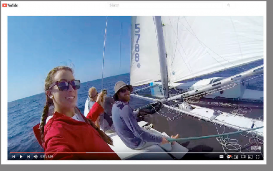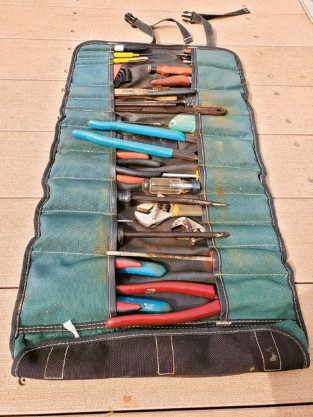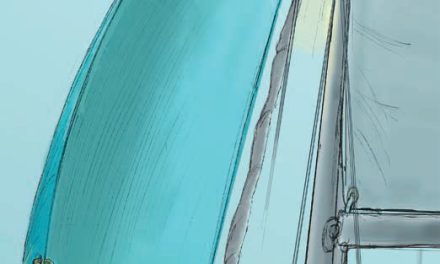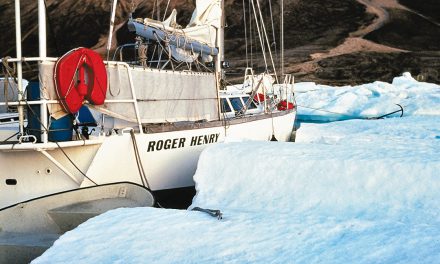Two friends’ seasonal ritual in a frozen boatyard sweetens the long Canadian winter.
Issue 142: Jan/Feb 2022
It is mid-January, Quebec winter at its best. The day is sunny, the air crisp, and the sky a deep blue you just don’t see anywhere else. My old Saab starts without hesitation, despite the cold. Nordic genes are still running strong.
Half an hour later we are at the yacht club, where all the boats are hauled up for the winter. Most are covered with tarps, but some are left bare to face the elements. I can never understand it—is it laziness? Lack of time? As I walk between sleeping boats, I feel sorry for the uncovered ones. They look very much like orphans to me.
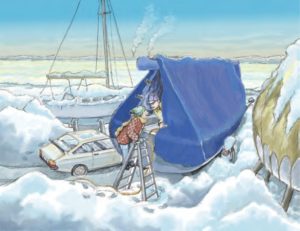 But my gloomy thoughts soon disperse, because there is Old Duck, my Vivacity 20, the very epitome of my freedom. Surrounded by bigger boats towering over her with their deep-draft keels, she sits low on her trailer, her two bilge keels canted slightly outward. The tarp is clear of snow or ice and the lines holding it to the trailer frame are still taut.
But my gloomy thoughts soon disperse, because there is Old Duck, my Vivacity 20, the very epitome of my freedom. Surrounded by bigger boats towering over her with their deep-draft keels, she sits low on her trailer, her two bilge keels canted slightly outward. The tarp is clear of snow or ice and the lines holding it to the trailer frame are still taut.
I walk all around her, making sure everything is OK. With the mast serving as a ridge pole, the tarp’s steep sides make a toboggan run for any snow, and small hills surround the boat on the ground. Both ends of the tarp tent are rolled up together and kept in place with plastic spring clamps. They hold the tarp tightly closed even during the strongest winter winds.
I position a ladder next to the stern and tie it fast to the lower rudder fitting. I remove the spring clamps one by one, unroll the tarp ends, and re-clamp them open. Now I have easy access to the cockpit, up the ladder and over the stern.
The strong wooden A-frame sits on the lazarette’s small deck, and it will take some yoga-inspired movements to navigate over it and into the cockpit. But that comes later; first, I climb back down with the end of a power cable that had been wrapped around the mainsheet horse and plug it into the electrical box a few feet away. I put my ear next to the hull to see if I can hear the gentle rumbling of my electric heater fan in the main cabin. I can. Good.
I walk to the harbor, where the vast expanse of the ice-covered lake shimmers in the sun. The distant shore and St. Lawrence Seaway are barely visible—no ships in sight. I walk for the next half an hour, enjoying the sun, deeply inhaling fresh winter air, and imagining white sails and the harbor full of masts. It will come soon, I know. We just need to hang on four more months.
Finally, I return to Old Duck, climb aboard, and look around carefully under the tarp for any critters such as racoons who may have taken up residence (it happens frequently around here). All clear.
I open up the boat and step below, where it’s already nice and warm. To keep it that way, I close the slider, replace the lower hatch board, and slide a piece of acrylic into the upper board’s space so I can look outside.
I remove a water jug from my backpack and fill the kettle. I spend the next few minutes turning the hand crank on my Grundig radio. I’ve removed the batteries for the winter, and using the crank keeps rechargeable batteries inside alive. Minutes later, the Montreal Classic Radio station comes to life. Beethoven. Perfect.
I hear some commotion outside. The ladder rattles, and Ante’s head shows up against the bright triangle of light over the stern. He scrambles below, and once he’s settled into his usual place in the port quarter berth, I take out two small glasses and a bottle of walnut elixir—homemade liquor made with green walnuts. As the song says, “We toast to the future, and we drink to the past.” The liquor is cold yet warms us, nevertheless.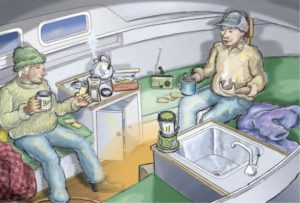
I turn on the stove to heat up the kettle and pull out two coffee mugs—the blue one is mine, the white one with our yacht club burgee is his—and a jar of Nescafé. During winter “sailing” we keep it simple. Summer is another story; sometimes I make a real Turkish coffee, sometimes the espresso machine is plugged in. Yet it is often Nescafé that saves the day.
The kettle whistles, and I turn off the stove and pour just a little cold water into the kettle. It brings the temperature down and helps the Nescafé make a nice creamy top in the coffee mug. I dig deeper in the cambuse (the pantry) and find an open box of chocolate wafers. “Made in Croatia” is written on the packaging. We were both born and raised in Croatia, a long time ago.
The wafers are cold and crispy. Steam rises from our mugs. The cabin is warm and comfortable; the thermometer shows 24°C (75°F).
Now discussion begins, a serious one, indeed. Will I use wind-vane steering for my next long trip? I believe not; I am more inclined to get two electric tiller pilots and a bigger battery. Where to mount additional solar panels required in that case? Etc., etc. We talk, we make plans.
Discussion turns toward the outboard choice I need to make. Last summer my old Evinrude decided it had had enough. After spending a decent amount of money and a lot of effort that ended with a deep and painful cut on my hand, I gave up. It did not want to come back to life. Now I need to buy another outboard. I hate the look of new outboards; they are just plain ugly, too big and heavy in my opinion. Any new model would look so out of place on Old Duck’s stern.
Ante presents his arguments. I do not agree. Not for the first time, we reach a total impasse. We will continue this particular subject next time. We move on and discuss past and future voyages, upgrades, and various projects done and to be done on our boats.
Ante is wondering aloud: Are we the only two sailors in Montreal in the middle of winter, sitting in a small boat on trailer and covered for the season? It is hard to say. I tend to think that we are. It is our winter sailing. The boat is still, but we are not.
This ritual of ours makes the winter less harsh for a grounded sailor. It creates continuity from one sailing season to another. It makes short days and long winter nights less detrimental to our spirits. And there is no better place than a small boat cabin to have a mug of hot coffee on a cold winter day.
It is time to go. We do not want to, but we know that our “day sail” is over. I open the companionway, and the cold air rushes in. We put on our jackets. Ante goes down the ladder while I check the cabin, making sure everything is turned off except the heater, which I return to maximum heat setting.
After closing the companionway, I descend the ladder and disconnect the power cable, wrapping the end around the mainsheet horse again. Then I close the tarp, fastening it tightly with spring clamps.
We walk to the parking lot. Ante is saying to me, as always, “This was very good, we need to repeat it.” Of course, we both know it was good, and we know that we will repeat it. There is still plenty of time before the winter is over.
Zoran Glozinic is a retired business professional who has been messing about in boats and old cars all his life. He lives in Laval, Quebec, where he divides his time between a good old English bilge-keeler and a 19-year-old Saab car.
Thank you to Sailrite Enterprises, Inc., for providing free access to back issues of Good Old Boat through intellectual property rights. Sailrite.com


